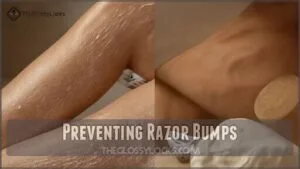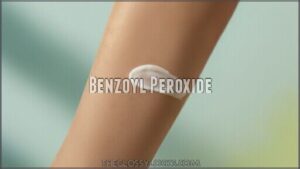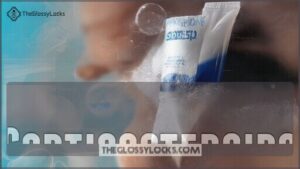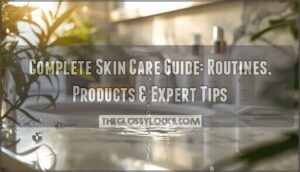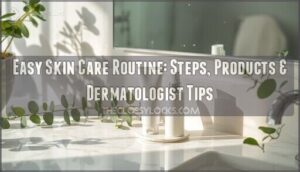This site is supported by our readers. We may earn a commission, at no cost to you, if you purchase through links.
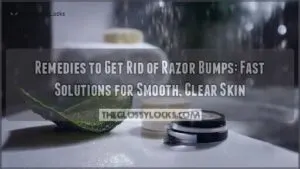
To start, apply cool or warm compresses to soothe the skin and bring ingrown hairs to the surface. Using aftershave or aloe can also help calm irritation.
Exfoliating and moisturizing are key to preventing bumps. For more severe cases, try home remedies like aloe vera gel or tea tree oil.
By understanding what causes razor bumps, you can take the first step for smoother skin – and there’s more to explore on how to achieve that.
Table Of Contents
- Key Takeaways
- Causes of Razor Bumps
- Preventing Razor Bumps
- Home Remedies for Razor Bumps
- Treating Razor Bumps
- Managing Razor Bump Symptoms
- Frequently Asked Questions (FAQs)
- Is it possible to prevent razor bumps when shaving?
- What causes razor bumps?
- What are the risk factors for razor bumps?
- How do doctors diagnose razor burns?
- What are the complications of razor burns?
- How to get rid of razor bumps fast?
- How to get rid of razor bumps in a private area?
- How long do razor bumps take to go away?
- What cures razor bumps fast?
- How to get rid of razor bumps down there naturally?
- Conclusion
Key Takeaways
- You can minimize razor bumps by shaving in the direction of hair growth, using sharp razors, and moisturizing regularly to reduce irritation and ingrown hairs.
- To get rid of razor bumps, you can try gentle home treatments like aloe vera and tea tree oil for mild irritation, and consider salicylic acid or benzoyl peroxide products for persistent bumps.
- You’re more likely to experience razor bumps if you have curly or coarse hair, shave frequently, or use dull razors, so it’s essential to adjust your shaving technique and routine accordingly.
- By exfoliating your skin, using lubrication options like shaving cream or gel, and moisturizing after shaving, you can reduce your risk of getting razor bumps and achieve smoother, clearer skin.
Causes of Razor Bumps
Razor bumps happen when shaved hairs grow back into your skin, causing red, irritated bumps that are sometimes sore or itchy.
Razor bumps cause red irritated bumps and itchiness when shaved hairs grow back into the skin
You’re more likely to develop them if you have curly hair, sensitive skin, or use improper shaving techniques.
Ingrown Hairs
Even if you’re careful, razor bumps often start with ingrown hairs.
When hair curl direction changes, the sharp tip can pierce the skin—think skin penetration and follicle blockage.
Here’s what you might notice:
- Raised, red bumps that itch or sting
- Tiny, pus-filled spots
- Skin inflammation around follicles
- Discomfort that worsens without proper exfoliation techniques or tea tree oil
Curly Hair Types
Curly hair doesn’t just look different—it acts different, too.
Your unique curl pattern and higher hair porosity mean strands often twist back into the skin after shaving, causing razor bumps and stubborn ingrown hairs.
Product buildup and struggles with moisture retention can clog pores.
Defining curls gets tricky, so gentle exfoliation techniques are key before any hair removal.
Improper Shaving Techniques
Watch out for dull razors, shaving against the grain, and dry shaving—these bad habits can leave your skin begging for mercy.
Skipping shaving cream, clogging up your razor, or stretching your skin too tight are surefire routes to razor bumps and irritation.
Use these shaving tips to avoid ingrown hairs and keep your face feeling smooth.
Sensitive Skin Conditions
You’re more prone to razor bumps if you have sensitive skin conditions like eczema, psoriasis, or rosacea.
These concerns increase your irritation threshold, making skin soothing essential to reduce inflammation and skin irritation, especially when shaving, to prevent razor bumps on sensitive skin.
Bacterial Infections
You’re likely to experience bacterial infections, a common cause of razor bumps.
To prevent this:
- Practice good hygiene
- Use antiseptic products
- Disinfect your razor, promoting infection prevention and microbial control, key to avoiding skin infection and ensuring effective wound care.
Preventing Razor Bumps
You can prevent razor bumps by taking a few simple steps before and after shaving.
Prevent razor bumps with simple steps before and after shaving for smoother skin
By exfoliating your skin, using sharp razors, and shaving in the direction of hair growth, you’ll reduce your risk of getting razor bumps and achieve smoother, clearer skin.
Exfoliating Before Shaving
You can prevent razor bumps by exfoliating before shaving, which removes dead skin cells and helps ingrown hairs grow outwards.
Exfoliation benefits include reduced skin irritation, and using the right scrub type is key, especially for sensitive skin, to minimize razor bumps and ingrown hairs, with exfoliating and exfoliation being crucial steps.
Using Sharp Razors
Using sharp razors reduces razor bumps and razor burn.
Dull blades cause irritation, ingrown hairs, and skin sensitivity.
Regular razor maintenance, including blade disinfection, helps prevent razor bumps.
Choose a razor with a comfortable shaving angle and suitable blade material for smooth shaving and razor burn relief.
Proper tools like high quality razors can improve the shaving experience.
Shaving in Hair Growth Direction
You’ll get a smoother shave by shaving in hair growth direction.
This reduces irritation, prevents ingrowns, and minimizes cuts.
Remember to cleanse the skin before shaving to remove dirt and oil.
Try these tips:
- Shave with hairline direction
- Use light strokes
- Avoid applying too much pressure
Avoiding Dry Shaving
You’ll reduce shaving irritation by avoiding dry shaving, which causes friction and increases razor bumps.
Opt for lubrication options like shaving cream or gel to keep your skin hydrated and prepared for a smooth shave, minimizing the risk of razor bumps and post-shave irritation, by using lubrication options and maintaining hydrated skin.
Moisturizing After Shaving
After shaving, you’ll want to moisturize to soothe skin.
Consider these:
- Aftershave balm
- Skin moisturizers
- Hydration creams for sensitive skin, providing hydration benefits and skin soothing techniques to reduce postshave irritation.
This will help to reduce irritation and keep your skin healthy.
Home Remedies for Razor Bumps
You can try several home remedies to help get rid of razor bumps, and they’re often easy to find in your kitchen or bathroom.
By using remedies like aloe vera gel or tea tree oil, you can reduce inflammation and soothe irritated skin, helping you achieve smooth, clear skin.
Aloe Vera Gel
You can apply aloe vera gel to soothe razor bumps.
One cause can be shaving against growth, so consider your shaving technique.
| Aloe Application | Gel Benefits | Skin Hydration |
|---|---|---|
| Reduces inflammation | Soothes skin | Hydrates skin |
| Relieves irritation | Calms redness | Softens skin |
| Natural remedy | Aloe compounds | Skin relief |
| Easy to use | Affordable | Effective |
| Gentle on skin | Non-irritating | Natural ingredients |
The benefits of using aloe vera include its ability to reduce inflammation and relieve irritation, making it a great natural remedy for skin issues.
Tea Tree Oil
You can use tea tree oil to combat razor bumps due to its anti-inflammatory and antiseptic properties, which help soothe ingrown hairs.
Dilute TTO before application to avoid side-effects, and consider alternatives if irritation occurs, leveraging TTO benefits for smoother skin.
Many users find tea tree products helpful for skin care.
Witch Hazel
You can try witch hazel to soothe razor bumps and ingrown hairs. Its anti-inflammatory properties help calm the skin.
You can also find specialized witch hazel products.
Some benefits include:
- Reducing inflammation
- Soothing ingrown hairs
- Calming skin irritation
- Preventing infection
- Promoting skin healing
Coconut Oil
Coconut oil’s natural anti-inflammatory properties make it a gentle remedy for razor bumps and ingrown hairs.
The oil’s medium-chain fatty acids penetrate skin easily, reducing irritation while creating a protective barrier.
Apply a thin layer to clean, dry skin twice daily.
This natural remedy softens hair follicles and moisturizes without clogging pores, promoting faster healing.
Warm Compresses
You can find relief from razor bumps with a warm compress.
Apply a warm, damp cloth to the affected area to reduce skin inflammation.
This home remedy provides enhanced relief when used 2-3 times daily, utilizing materials like cotton or towels, as an alternative to other compress alternatives.
Treating Razor Bumps
You’re taking the next step to treat razor bumps, and this is vital.
You can use treatments like benzoyl peroxide, salicylic acid, or corticosteroids to help reduce inflammation and prevent infection.
Benzoyl Peroxide
Beyond home remedies, stronger treatments exist. For stubborn razor bumps, think about benzoyl peroxide. It fights bacteria and removes dead skin, helping with skin inflammation reduction.
You can use medicated shaving cream. One key to prevention is to use proper shaving techniques.
Here’s how:
- Start with a low Benzoyl Peroxide Strength.
- Follow Application Techniques carefully.
- Watch for Side Effects, like skin irritation relief.
Treatment Duration varies. Always follow Product Recommendations and consult a dermatologist. Benzoyl peroxide can help with skin healing.
Salicylic Acid
Switching gears from benzoyl peroxide, salicylic acid truly stands out for fighting razor bumps.
Thanks to its acid exfoliation powers and pore penetration, it lifts away dead skin and stops ingrown hairs before they start.
You’ll appreciate its keratolytic effects for easing skin inflammation and keeping pores clear.
Salicylic acid is effective because it helps dissolve excess keratin buildup.
Look for gentle product formulations designed for daily use and safe inflammation reduction.
Glycolic Acid
Glycolic acid’s gentle touch offers your skin solid relief from razor bumps, sloughing off dead cells and freeing trapped hairs.
For best results:
- Opt for 5–10% acid concentration levels for daily skincare.
- Apply 2–3 times weekly, avoiding excessive exfoliation.
- Check product recommendations and watch for potential side effects like redness.
Glycolic acid benefits your skin with smoother, clearer results, providing a solution to common skincare issues with its gentle touch.
Corticosteroids
Sometimes, a bit of hydrocortisone cream, a mild topical steroid, can help calm razor bumps fast.
Cortisone cream reduces skin inflammation caused by shaving, acting as an antiinflammatory.
Stick to usage guidelines—overusing Topical Steroids or Oral Corticosteroids can lead to steroid side-effects.
Always choose the right potency levels, and talk to your doctor before stepping up treatments.
Antibiotic Ointments
A thin layer of antibiotic ointment can stop skin infection and reduce inflamed razor bumps fast.
Ointment application is easy—dab it gently on the affected area.
Watch for potential ointment side-effects or bacterial resistance, especially with frequent use.
For kids, check safety before pediatric use. If razor bumps persist, ask your doctor about alternative antibiotics or other topical treatments with antiinflammatory benefits.
Managing Razor Bump Symptoms
Managing razor bump symptoms means calming redness, soothing itch, and stopping infection before it starts.
You’ll need a gentle touch and a few smart steps to keep your skin smooth while it heals.
Reducing Inflammation
To reduce inflammation from razor bumps, apply natural anti-inflammatories like aloe vera or tea tree oil.
Cooling techniques can also help calm the skin, reducing the inflammatory response and promoting a healthy skin barrier to prevent scars.
Proper shaving cream application can also help, as it can reduce razor burn, which is a key factor in preventing inflammatory response and ultimately scars.
Relieving Itchiness
To relieve itching from razor bumps, try these:
- Cooling applications
- Antihistamine use
- Calamine lotion.
Gentle cleansing and loose clothing can also provide skin relief, soothing itching and reducing inflammation with anti-inflammatory skin soothers.
Preventing Infection
To prevent infection, apply topical antibiotic creams and avoid picking bumps.
Keep razors clean and swap them often to prevent bacteria buildup, emphasizing cleanliness importance and antiseptic application, like tea tree oil, for skin disinfection and avoiding contamination, highlighting the role of antiseptic.
Promoting Skin Healing
You can promote skin healing by using natural remedies like aloe vera, which boosts collagen production and hydration, while soothing irritation and aiding in scar reduction.
A key aspect of effective razor bump treatment and ingrown hair removal through home remedies is scar reduction, which is aided by the natural remedies.
Avoiding Further Irritation
To avoid further irritation, wear loose clothing and use gentle cleansers.
Avoid scratching ingrown hairs, and prioritize sun protection and hydration.
This helps prevent razor bumps and supports your razor bump treatment and overall skin care routine.
Frequently Asked Questions (FAQs)
Is it possible to prevent razor bumps when shaving?
You can minimize razor bumps by shaving in the direction of hair growth, using sharp razors, and moisturizing regularly to reduce irritation and ingrown hairs.
What causes razor bumps?
You get razor bumps when hair curls back into the skin, causing inflammation, often due to improper shaving techniques, curly hair, or sensitive skin types.
What are the risk factors for razor bumps?
You’re more likely to experience razor bumps if you have curly or coarse hair, shave frequently, or use dull razors, especially if you’re African American or have sensitive skin.
How do doctors diagnose razor burns?
You’ll be surprised that 60% of African Americans experience razor bumps. Doctors diagnose razor burns through physical exams, reviewing medical history, and sometimes biopsies to rule out other skin conditions accurately.
What are the complications of razor burns?
You may experience infections, scarring, or ingrown hairs if razor burns aren’t properly treated, leading to further skin irritation and potentially severe complications.
How to get rid of razor bumps fast?
You can reduce razor bumps by exfoliating, using warm compresses, and applying aloe vera or tea tree oil to soothe and calm irritated skin quickly and effectively.
How to get rid of razor bumps in a private area?
Notably, you’re dealing with razor bumps in a private area; gently exfoliate, apply aloe vera or coconut oil to soothe and calm irritated skin, promoting healing and comfort.
How long do razor bumps take to go away?
Razor bumps typically clear up within two to three weeks if you stop shaving the affected area.
However, they’ll keep coming back if you continue shaving without changing your technique or routine.
What cures razor bumps fast?
Apply warm compresses to open pores, then gently exfoliate with tea tree oil or aloe vera gel. These natural anti-inflammatories reduce swelling and redness quickly while preventing infection.
How to get rid of razor bumps down there naturally?
Try warm compresses on the area to open pores and release trapped hairs. Apply aloe vera gel to reduce inflammation. Gently exfoliate with sugar scrub to prevent future bumps.
Conclusion
Ready to achieve bump-free skin? These remedies to get rid of razor bumps offer effective solutions for smoother results.
Start with gentle home treatments like aloe vera and tea tree oil for mild irritation. For persistent bumps, consider salicylic acid or benzoyl peroxide products.
Prevention remains your best defense through proper exfoliation, sharp razors, and consistent moisturizing. With patience and the right approach, you’ll transform your shaving routine and enjoy clearer, more comfortable skin every day.
- https://www.womenshealthmag.com/health/a41022047/how-to-get-rid-of-razor-bumps/
- https://naturalremedyideas.com/get-rid-of-razor-bumps/
- https://getbevel.com/blogs/articles/what-home-remedies-work-best-to-get-rid-of-razor-bumps?srsltid=AfmBOop_TdHerAw386LapUGXdhrv0N7XUx2R3WhBye_AzgCgnteGbIlL
- https://www.healthline.com/health/razor-bumps
- https://www.medicalnewstoday.com/articles/325471

